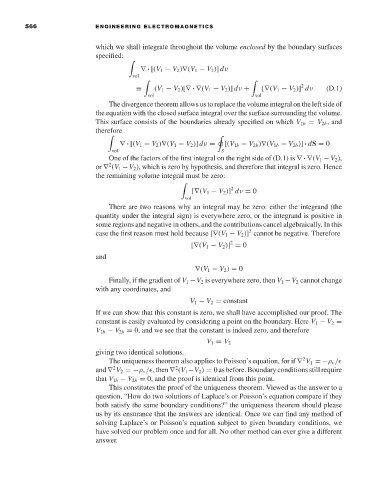Page 584 - Engineering Electromagnetics, 8th Edition
P. 584
566 ENGINEERING ELECTROMAGNETICS
which we shall integrate throughout the volume enclosed by the boundary surfaces
specified:
∇ · [(V 1 − V 2 )∇(V 1 − V 2 )] dν
vol
2
≡ (V 1 − V 2 )[∇ · ∇(V 1 − V 2 )] dν + [∇(V 1 − V 2 )] dν (D.1)
vol vol
The divergence theorem allows us to replace the volume integral on the left side of
the equation with the closed surface integral over the surface surrounding the volume.
This surface consists of the boundaries already specified on which V 1b = V 2b , and
therefore
∇ · [(V 1 − V 2 )∇(V 1 − V 2 )] dν = [(V 1b − V 2b )∇(V 1b − V 2b )] · dS = 0
vol S
One of the factors of the first integral on the right side of (D.1) is ∇ · ∇(V 1 − V 2 ),
2
or ∇ (V 1 −V 2 ), which is zero by hypothesis, and therefore that integral is zero. Hence
the remaining volume integral must be zero:
2
[∇(V 1 − V 2 )] dν = 0
vol
There are two reasons why an integral may be zero: either the integrand (the
quantity under the integral sign) is everywhere zero, or the integrand is positive in
some regions and negative in others, and the contributions cancel algebraically. In this
2
case the first reason must hold because [∇(V 1 − V 2 )] cannot be negative. Therefore
2
[∇(V 1 − V 2 )] = 0
and
∇(V 1 − V 2 ) = 0
Finally, if the gradient of V 1 −V 2 is everywhere zero, then V 1 −V 2 cannot change
with any coordinates, and
V 1 − V 2 = constant
If we can show that this constant is zero, we shall have accomplished our proof. The
constant is easily evaluated by considering a point on the boundary. Here V 1 − V 2 =
V 1b − V 2b = 0, and we see that the constant is indeed zero, and therefore
V 1 = V 2
giving two identical solutions.
2
The uniqueness theorem also applies to Poisson’s equation, for if ∇ V 1 =−ρ ν /
2
2
and ∇ V 2 =−ρ ν / , then ∇ (V 1 −V 2 ) = 0as before. Boundary conditionsstill require
that V 1b − V 2b = 0, and the proof is identical from this point.
This constitutes the proof of the uniqueness theorem. Viewed as the answer to a
question, “How do two solutions of Laplace’s or Poisson’s equation compare if they
both satisfy the same boundary conditions?” the uniqueness theorem should please
us by its ensurance that the answers are identical. Once we can find any method of
solving Laplace’s or Poisson’s equation subject to given boundary conditions, we
have solved our problem once and for all. No other method can ever give a different
answer.

